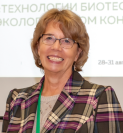
Prof. Dr. Vera Terekhova
Lomonosov Moscow State University, Russia
Title: MELANIN-CONTAINING FUNGI: INDICATION OF CHEMICAL SOIL POLLUTION AND BIOTECHNOLOGICAL POTENTIAL
Abstract:
Micromycetes are one of the most extensive ecological groups of organisms that ensure the “health” of natural ecosystems. The involvement of mycobiota parameters in the biodiagnostics of the ecological quality of natural environments is an actual technological technique necessary for improving the system of ecological risk assessments. Soil micromycetes respond to changes in the physical and chemical parameters of the environment, primarily the content of organic matter. In this regard, in our studies, the task of establishing regularities in changes in mycobiotic parameters in soils of different humus status under similar conditions of technogenic load is considered as a priority task.
The issues of widespread use of mycological indices remain debatable due to the relatively high resistance to pollutants. For a practical assessment of ecological risk, such parameters of mycobiota as the frequency of occurrence of indicator species, the proportion of melanized forms, diversity indices, and some others are appropriate. Modern methodological approaches and methods open up possibilities for analyzing fungal communities at a new level with the involvement of biochemical markers of community reconstruction, which allow for mass screening of the structure of communities (metagenomics, lipidomics) and statistical models for analyzing the distribution of species sensitivity, in particular, according to the SSD (Species Sensitivity) type. distribution).
On the example of the results of mycoindication of radioactive contamination of soils in uranium mine dumps (Kadji-Sai village, Kyrgyzstan), critical values of six indicators of soil contamination are estimated to provide a given acceptable probability of environmental risk. Based on the SSD model, an original method for substantiating the environmental risk of technogenic soil pollution is proposed. An analysis of the distribution of melanin-containing fungi in contaminated soils emphasizes the significant role of the level of organic matter in determining the bioindicative reliability of this indicator of mycobiota.
Biography:
Education
1975 Dipl. Biol. Plant Physiol., Moscow State University (with distinction)
2008 PhD, Mycology, Moscow State University
Ultimate Academic Degree
M.Sc., Biology, Moscow State University
PhD, Botany&Mycology
Dr.Sci, Mycology&Ecology
Scientific & Professional Career:
Professor, Moscow State University, Dept. of Soil Science (since 2021)
Head of Ecotoxicol Laboratory, Moscow State University (since 2002)
Head of Laboratory for Ecological Soil Function Institute of Ecology and Evolution RAS, Moscow (2013-2015)
Leader Research Scientist, Institute of Ecology and Evolution RAS, Moscow
Head of Mycology Laboratory, Institute of Volga River Basin Ecology, Russian Academy of Science, Togliatti, Russia (1987-1995)
Researcher, Moscow State University, Moscow
Dept. of Mycology and Algology (1975-1987)
Expertise
Soil ecology, Ecotoxicology, Bioassay,
Bioindication, Biodiversity, Mycology,
Humus Substances, Waste Damage, Remediation, Nanomaterials,
Adsorbents, Biothechnology
Graduate Advisory Experience
> 10 Postdocs finished
> 20 Doctoral students finished (8 with summa cum laude)
> 30 MSc, Diploma & BSc students
Scientific Activities
> 300 scientific publication
- 26 books , 12 patents
>120 presentations at scientific meetings
- 3 memberships in editorial boards of journals,
- 4 memberships in editorial boards of proceedings
- 23 memberships in program committees
> 20 journals reviewer
Membership in Scientific Societies:
2008 Society of Environmental Toxicology and Chemistry(President of SETAC Russian Language Branch _2013-2016)
2007 International Society of Environmental Indicators 2002International Humic Substances Society
2000 V.Dokuchaev Soil Science Society
1990 European Mycological Association
1990 National Academy of Mycology,
1990 Moscow Society of Nature Experts